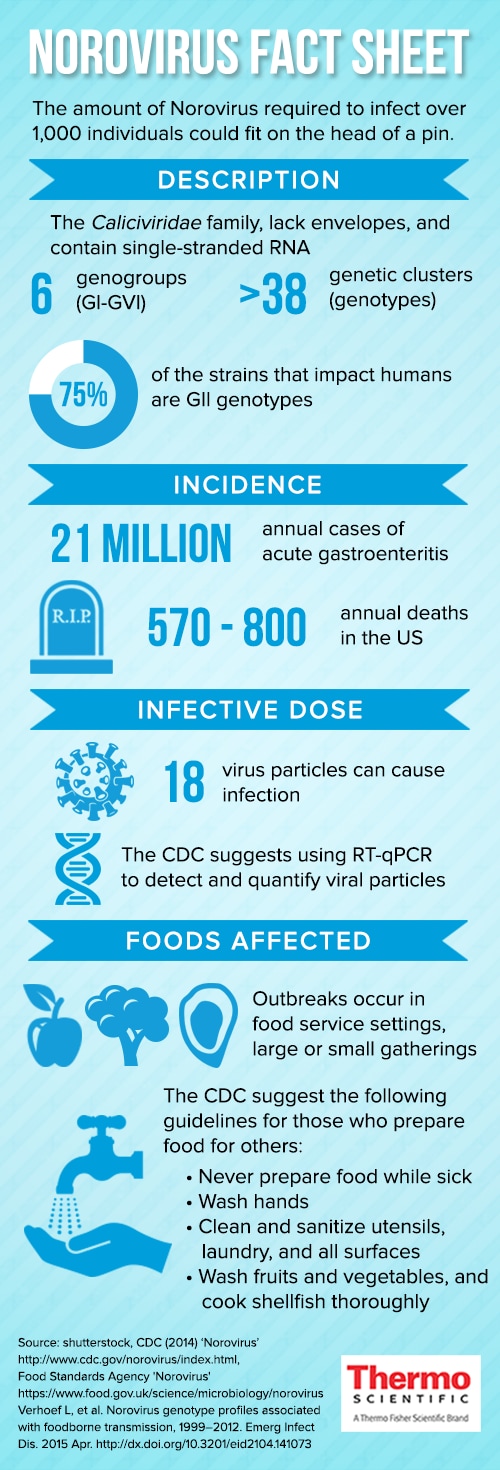 The amount of Norovirus required to infect over 1,000 indviduals could fit on the head of a pin, rendering the pathogen highly contagious and the most likely culprit in outbreaks of foodborne illness.
The amount of Norovirus required to infect over 1,000 indviduals could fit on the head of a pin, rendering the pathogen highly contagious and the most likely culprit in outbreaks of foodborne illness.
Description
Collectively, noroviruses belong to the Caliciviridae family, lack envelopes, and contain single-stranded RNA. Outside of this, the genetically diverse viruses belong to six genogroups (GI-GVI) and >38 genetic clusters (genotypes)1. The majority (75%) of the strains that impact humans are GII genotypes2.
Incidence
Norovirus is the most common source of outbreaks of foodborne illness, resulting in over 21 million annual cases of acute gastroenteritis and even 570 to 800 annual deaths in the US alone.2 Because it is highly infectious with contagions that linger approximately two weeks after recovery, norovirus can be transmitted through contact with infected individuals, contaminated surfaces, or food products compromised with this pathogen.
Infective dose
Infection with norovirus can occur with exposure to a mere 18 virus particles.2 The Centers for Disease Control and Prevention recommend molecular diagnostic protocols like real-time reverse transcription-polymerase chain reaction (RT-qPCR) assay for the detection and quantification of viral particles in food products, water, environmental samples, and human body fluids (stool, vomit).
Foods affected
Most outbreaks of norovirus occur in food service settings when infected individuals handle either raw or cooked food products. This is a particular concern in environments that serve large quantities of guests (e.g. restaurants, hospitals, care facilities, schools, cruise ships), but outbreaks can also occur at smaller gatherings (e.g. family dinners). Foods like oysters, vegetables, and fruits can also become contaminated at their origin and carry norovirus down the food supply chain. Specific to foodborne vectors, the Centers for Disease Control recommend that individuals who prepare food for others observe the following guidelines for minimizing exposure to norovirus:
-
Never prepare food for others while sick or for >48 hours following the cessation of symptoms
-
Employ good hand washing practices
-
Clean and sanitize utensils, kitchen/dining laundry, and food preparation surfaces
-
Always wash fruits and vegetables before use and observe thorough cooking practices for shellfish
Read more on innovative testing solutions for Norovirus and other foodborne pathogens.
References
1. Verhoef L, Hewitt J, Barclay L, Ahmed S, Lake R, Hall AJ, et al. Norovirus genotype profiles associated with foodborne transmission, 1999–2012. Emerg Infect Dis. 2015 Apr. http://dx.doi.org/10.3201/eid2104.141073
2. Centers for Disease Control and Prevention (2014) ‘Norovirus’ http://www.cdc.gov/norovirus/index.html
3 Food Standards Agency ‘Norovirus’ https://www.food.gov.uk/science/microbiology/norovirus


Leave a Reply